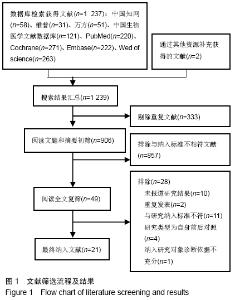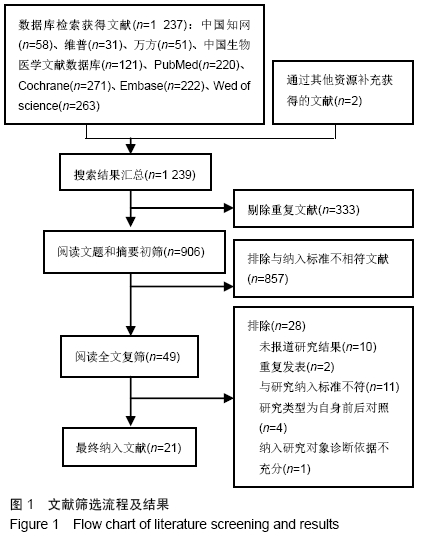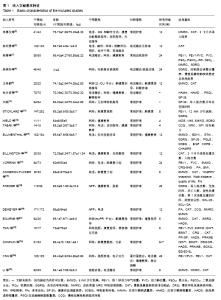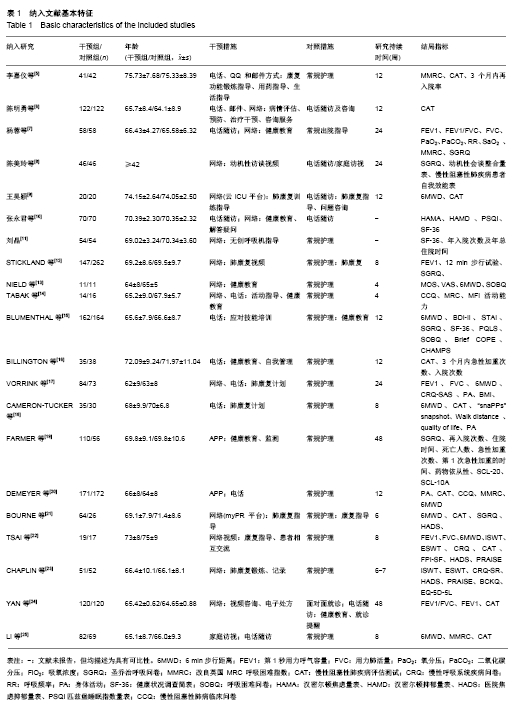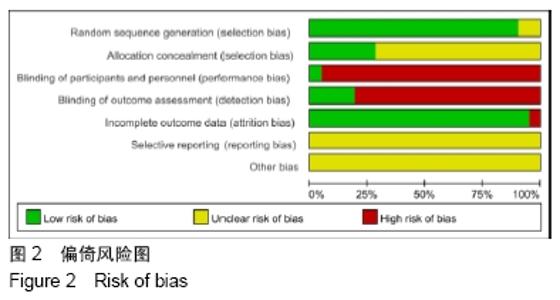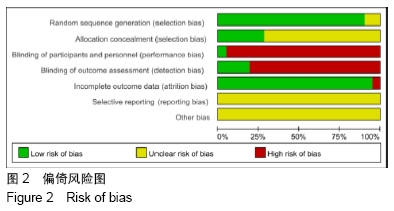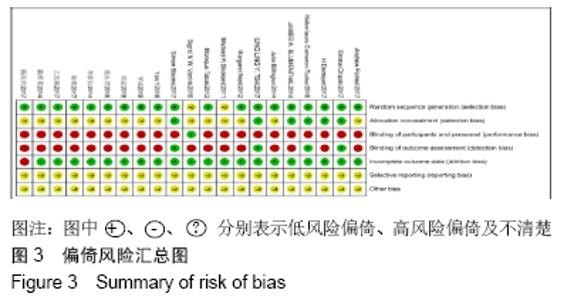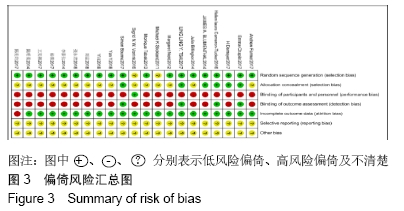Chinese Journal of Tissue Engineering Research ›› 2020, Vol. 24 ›› Issue (8): 1306-1312.doi: 10.3969/j.issn.2095-4344.1500
Remote rehabilitation applied in patients with stable stage of chronic obstructive pulmonary disease: a meta-analysis
Ding Meizhu1, Hu Peixin2, Shen Qian2, Zhong Shuxian2, Yang Yalan2, Li Chun2
- 1the Second Affiliated Hospital of Guangzhou University of Chinese Medicine, Guangzhou 510120, Guangdong Province, China; 2Guangzhou University of Chinese Medicine, Guangzhou 510006, Guangdong Province, China
-
Received:2019-03-11Revised:2019-03-20Accepted:2019-04-19Online:2020-03-18Published:2020-01-23 -
About author:Ding Meizhu, Master, Associate chief nurse, the Second Affiliated Hospital of Guangzhou University of Chinese Medicine, Guangzhou 510120, Guangdong Province, China -
Supported by:the Scientific Research Project of Chinese Medicine of Guangdong Provincial Hospital of Chinese Medicine, No. YN2018YY10
CLC Number:
Cite this article
Ding Meizhu, Hu Peixin, Shen Qian, Zhong Shuxian, Yang Yalan, Li Chun. Remote rehabilitation applied in patients with stable stage of chronic obstructive pulmonary disease: a meta-analysis[J]. Chinese Journal of Tissue Engineering Research, 2020, 24(8): 1306-1312.
share this article
| [1] Global Initiative for Chronic Obstructive Lung Disease. Global strategy for the diagnosis,management and prevention of chronic obstructive pulmonary disease 2019 report.[2018-12-02]. https://goldcopd.org/gold-reports/. [2] WALKER PP, POMPILIO PP, ZANABONI P, et al.Telemonitoring in Chronic Obstructive Pulmonary Disease (CHROMED). A Randomized Clinical Trial.Am J Respir Crit Care Med. 2018;198(5):620-628. [3] KALTSAKAS G, PAPAIOANNOU A, VASILOPOULOU M, et al. Telemonitoring in COPD: the CHROMED study, a randomized clinical trial.AJRCCM Articles in Press.2018:1-53. [4] HIGGINS JPT GS. Cochrane Handbook for Systematic Reviews of Interventions Version 5.1.0//Cochrane handbook for systematic reviews of interventions/.Wiley-Blackwell.2008;102-108. [5] 李嘉仪,段鸿露,刘雪琴.慢性阻塞性肺疾病患者的远程护理干预[J].护理学杂志,2014,29(19):8-10. [6] 陈明勇,刘小英,吴友茹,等. 远程医学干预对慢性阻塞性肺疾病稳定期患者慢性阻塞性肺疾病评估测试评分的影响[J].华西医学,2014,29(10): 1807-1809. [7] 杨蓉,胡艺,李蔚,等.动态随访及网络平台健康教育在COPD患者随访中的应用[J]. 国际呼吸杂志,2017,37(9):671-674. [8] 陈美玲,卢焕平,梁宝卿.基于微信平台的远程动机性访谈在COPD患者延续性护理中的应用[J].护理实践与研究,2017,14(19):41-43. [9] 王昊颖. 远程医疗技术对家庭病房慢性阻塞性肺疾病患者肺康复的影响[D].济南:山东大学,2017. [10] 张永君,高娜,何敏,等.定时随访及网络平台干预在老年慢性阻塞性肺气肿患者中的康复效果研究[J].现代医学,2018,46(5):580-583. [11] 刘晶.慢阻肺合并慢性呼吸衰竭患者应用家庭无创通气的护理干预效果探讨[J].当代医学,2018,24(3):150-151. [12] STICKLAND MK, JOURDAIN T, WONG EY, et al.Using Telehealth Technology to Deliver Pulmonary Rehabilitation to Patients with Chronic Obstructive Pulmonary Disease. Can Respir J. 2011;18(4): 216-220. [13] NIELD M, HOO GWS. Real-Time Telehealth for COPD Self-Management Using Skype. COPD. 2012;9(6):611-619. [14] TABAK M, VOLLENBROEK-HUTTEN MM, VAN DER VALK PD, et al.A telerehabilitation intervention for patients with Chronic Obstructive Pulmonary Disease: a randomized controlled pilot trial. Clin Rehabil. 2014;28(6):582-591. [15] BLUMENTHAL JA, EMERY CF, SMITH PJ, et al.The Effects of a Telehealth Coping Skills Intervention on Outcomes in Chronic Obstructive Pulmonary Disease. Psychosom Med. 2014;76(8): 581-592. [16] BILLINGTON J, COSTER S, MURRELLS T, et al.Evaluation of a Nurse-Led Educational Telephone Intervention to Support Self-Management of Patients With Chronic Obstructive Pulmonary Disease: A Randomized Feasibility Study. COPD. 2015;12(4):395-403. [17] VORRINK SNW, KORT HSM, TROOSTERS T, et al.Efficacy of an mHealth intervention to stimulate physical activity in COPD patients after pulmonary rehabilitation. Eur Respir J. 2016;48(4):1019-1029. [18] CAMERON-TUCKER H, WOOD-BAKER R, JOSEPH L, et al.A randomized controlled trial of telephone-mentoring with home-based walking preceding rehabilitation in COPD. Int J Chron Obstruct Pulmon Dis. 2016;11:1991-2000. [19] FARMER A, WILLIAMS V, VELARDO C, et al.Self-Management Support Using a Digital Health System Compared With Usual Care for Chronic Obstructive Pulmonary Disease: Randomized Controlled Trial. J Med Internet Res. 2017;19(5):e144. [20] DEMEYER H, LOUVARIS Z, FREI A, et al.Physical activity is increased by a 12-week semiautomated telecoaching programme in patients with COPD: a multicentre randomised controlled trial. Thorax. 2017;72(5):415-423. [21] BOURNE S, DEVOS R, NORTH M, et al.Online versus face-to-face pulmonary rehabilitation for patients with chronic obstructive pulmonary disease: randomised controlled trial. BMJ Open.2017; 7(7): e014580. [22] TSAI LL, MCNAMARA RJ, MODDEL C, et al.Home-based telerehabilitation via real-time videoconferencing improves endurance exercise capacity in patients with COPD: The randomized controlled TeleR Study. Respirology. 2017;22(4):699-707. [23] CHAPLIN E, HEWITT S, APPS L, et al.Interactive web-based pulmonary rehabilitation programme: a randomised controlled feasibility trial.BMJ Open.2017;7:e013682. [24] YAN Y,LIU L,ZENG J,et al.Evaluation and Exploration on the Effect of the Management of Chronic Obstructive Pulmonary Disease in Rural Areas through an Internet-Based Network Consulting Room. Medical Principles and Practice,2018; 27(3),:222-226. [25] LI Y,FENG J,LI Y,et al.A new pulmonary rehabilitation maintenance strategy through home-visiting and phone contact in COPD. Patient Prefer Adherence. 2018;12:97-104. [26] 张小娥,张彩莲.慢性阻塞性肺疾病流行病学及疾病经济负担研究进展[J].中国慢性病预防与控制,2017,25(6):472-476. [27] 宋澜,王超.从覆盖到发展:医养结合养老模式三步走战略[J].求真,2016(9): 62-69. [28] 聂宝平,江成养,郭艳芬,等.互联网在慢性阻塞性肺疾病管理模式中的应用效果[J].临床护理杂志,2017,16(4):17-19. |
| [1] | Chen Junming, Yue Chen, He Peilin, Zhang Juntao, Sun Moyuan, Liu Youwen. Hip arthroplasty versus proximal femoral nail antirotation for intertrochanteric fractures in older adults: a meta-analysis [J]. Chinese Journal of Tissue Engineering Research, 2021, 25(9): 1452-1457. |
| [2] | Chen Jinping, Li Kui, Chen Qian, Guo Haoran, Zhang Yingbo, Wei Peng. Meta-analysis of the efficacy and safety of tranexamic acid in open spinal surgery [J]. Chinese Journal of Tissue Engineering Research, 2021, 25(9): 1458-1464. |
| [3] | Hu Kai, Qiao Xiaohong, Zhang Yonghong, Wang Dong, Qin Sihe. Treatment of displaced intra-articular calcaneal fractures with cannulated screws and plates: a meta-analysis of 15 randomized controlled trials [J]. Chinese Journal of Tissue Engineering Research, 2021, 25(9): 1465-1470. |
| [4] | Huang Dengcheng, Wang Zhike, Cao Xuewei. Comparison of the short-term efficacy of extracorporeal shock wave therapy for middle-aged and elderly knee osteoarthritis: a meta-analysis [J]. Chinese Journal of Tissue Engineering Research, 2021, 25(9): 1471-1476. |
| [5] | Wang Yongsheng, Wu Yang, Li Yanchun. Effect of acute high-intensity exercise on appetite hormones in adults: a meta-analysis [J]. Chinese Journal of Tissue Engineering Research, 2021, 25(8): 1305-1312. |
| [6] | Kong Desheng, He Jingjing, Feng Baofeng, Guo Ruiyun, Asiamah Ernest Amponsah, Lü Fei, Zhang Shuhan, Zhang Xiaolin, Ma Jun, Cui Huixian. Efficacy of mesenchymal stem cells in the spinal cord injury of large animal models: a meta-analysis [J]. Chinese Journal of Tissue Engineering Research, 2021, 25(7): 1142-1148. |
| [7] | Huang Dengcheng, Wang Zhike, Cao Xuewei. Intravenous, topical tranexamic acid alone or their combination in total knee arthroplasty: a meta-analysis of randomized controlled trials [J]. Chinese Journal of Tissue Engineering Research, 2021, 25(6): 948-956. |
| [8] | Li Yan, Wang Pei, Deng Donghuan, Yan Wei, Li Lei, Jiang Hongjiang. Electroacupuncture for pain control after total knee arthroplasty: a meta-analysis [J]. Chinese Journal of Tissue Engineering Research, 2021, 25(6): 957-963. |
| [9] | He Xiangzhong, Chen Haiyun, Liu Jun, Lü Yang, Pan Jianke, Yang Wenbin, He Jingwen, Huang Junhan. Platelet-rich plasma combined with microfracture versus microfracture in the treatment of knee cartilage lesions: a meta-analysis [J]. Chinese Journal of Tissue Engineering Research, 2021, 25(6): 964-969. |
| [10] | Hua Haotian, Zhao Wenyu, Zhang Lei, Bai Wenbo, Wang Xinwei. Meta-analysis of clinical efficacy and safety of antibiotic artificial bone in the treatment of chronic osteomyelitis [J]. Chinese Journal of Tissue Engineering Research, 2021, 25(6): 970-976. |
| [11] | Zhan Fangbiao, Cheng Jun, Zou Xinsen, Long Jie, Xie Lizhong, Deng Qianrong. Intraoperative intravenous application of tranexamic acid reduces perioperative bleeding in multilevel posterior spinal surgery: a meta-analysis [J]. Chinese Journal of Tissue Engineering Research, 2021, 25(6): 977-984. |
| [12] | Zhong Yuanming, Wan Tong, Zhong Xifeng, Wu Zhuotan, He Bingkun, Wu Sixian. Meta-analysis of the efficacy and safety of percutaneous curved vertebroplasty and unilateral pedicle approach percutaneous vertebroplasty in the treatment of osteoporotic vertebral compression fracture [J]. Chinese Journal of Tissue Engineering Research, 2021, 25(3): 456-462. |
| [13] | Li Yang, Zhang Mingyong. Meta-analysis of the effect of double Endobutton and clavicular hook plate on the treatment of acromioclavicular dislocation [J]. Chinese Journal of Tissue Engineering Research, 2021, 25(3): 463-470. |
| [14] | Li Yanle, Yue Xiaohua, Wang Pei, Nie Weizhi, Zhang Junwei, Tan Yonghai, Jiang Hongjiang. Intramedullary nail fixation versus plate fixation in the treatment of displaced midshaft clavicular fractures in adults: a meta-analysis [J]. Chinese Journal of Tissue Engineering Research, 2021, 25(3): 471-476. |
| [15] | Liu Chang, Han Shufeng. Interlocking intramedullary nail for proximal femur versus proximal femoral anti-rotation intramedullary nail or proximal femoral anti-rotation intramedullary nail of Asian for intertrochanteric fractures in older adults: a meta-analysis [J]. Chinese Journal of Tissue Engineering Research, 2021, 25(3): 477-485. |
| Viewed | ||||||
|
Full text |
|
|||||
|
Abstract |
|
|||||
